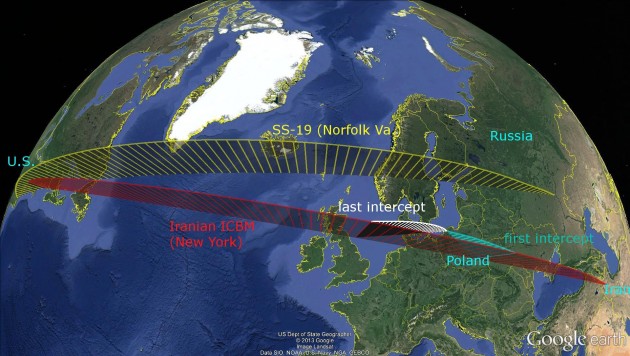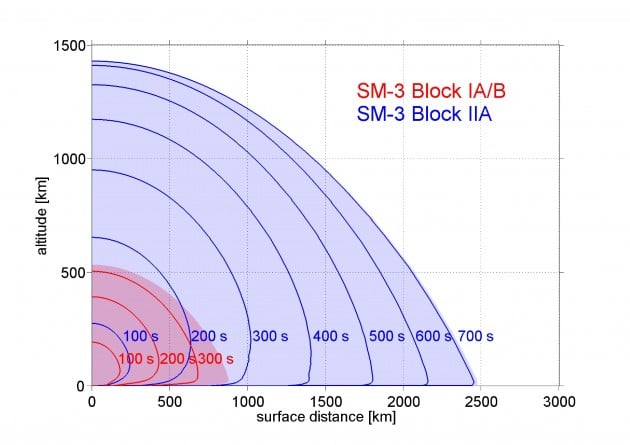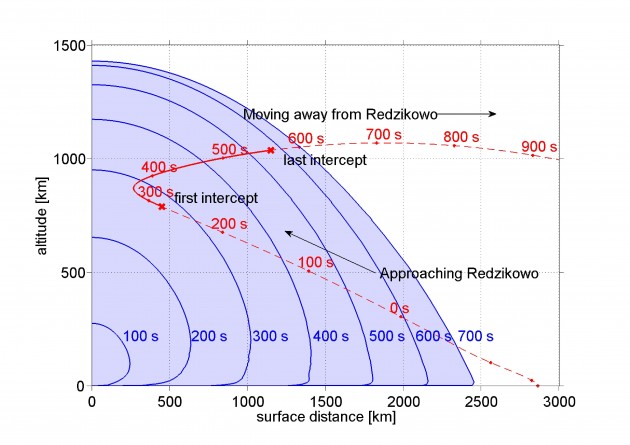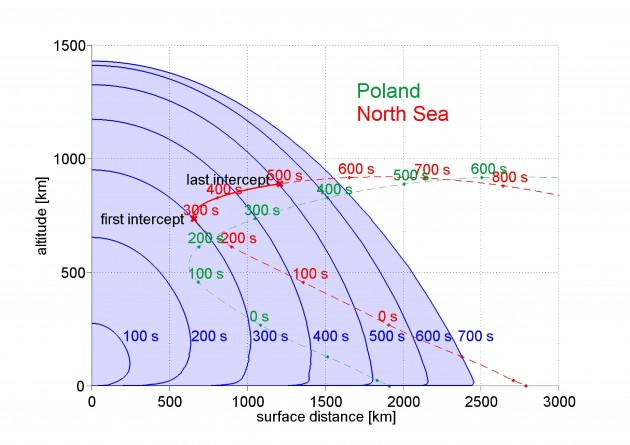Why Russia Keeps Moving The Football On European Missile Defense: Politics
Posted on

Simulated trajectory of an Iranian ICBM (red) and a Russian SS-19 (yellow) heading for targets in the United States (visualization using Google Earth).
America wants to use policy — talks on missile defense cooperation — to make Russia feel better about the European Phased Adaptive Approach (EPAA). But the Russians, who say they think EPAA threatens their ICBMs and thus creates all sorts of arms control problems. say technology — not policy — is the problem.
The Russian Foreign Ministry has continually insisted on legally binding guarantees that US missile defenses are not aimed at it and that would allow Russia access to sensitive aspects of the system. Russia has also threatened to deploy a range of countermeasures against NATO’s missile defenses, including tactical nuclear missile deployment in Kaliningrad and improvements to its strategic nuclear missile arsenal to make it capable of evading missile defense. Whether EPAA is aimed at Russia or technically capable of even potentially intercepting Russian missiles, however, are very different considerations. But the Russians seem to ignore that simple truth that the technology is limited by physics and engineering, not political considerations.
Ironically, moving the technology further away from Russian borders could increase the potential for its successful use against Russian missiles. So, whether or not Russian technical concerns could ever really be assuaged must be questioned.
Frank Rose, deputy assistant secretary of State for arms control, verification and compliance, restated in May 2013 the declaration made at the Chicago NATO Summit held in May 2012. “The NATO missile defense in Europe will not undermine strategic stability. NATO missile defense is not directed against Russia and will not undermine Russia’s strategic deterrence capabilities.” He went on to state that “through transparency and cooperation with the United States and NATO, Russia would see firsthand that this system is designed for ballistic missile threats from outside the Euro-Atlantic area, and that NATO missile defense systems can neither negate nor undermine Russia’s strategic deterrent capabilities.”
So let’s look at EPAA’s technology and its limits .
In Phase I of EPAA, allied navy ships in the Mediterranean have been equipped with SM-3 Block IA interceptors. Phase II adds more advanced SM-3 Block IB missiles and the interceptors will also be land-based in Romania. Under Phase III, faster SM-3 Block IIA interceptor missiles are to be based at Redzikowo, Poland. In addition to protecting Europe, these can potentially offer a first line of defense against future Iranian ICBMs heading for the East Coast of the United States. (Phase IV, which includes even faster Block IIB missiles in Poland, was cancelled in March 2013.) A hypothetical Iranian ICBM (based on the North-Korean Unha-3 space launcher) heading towards the Northwestern United States passes over Poland, as illustrated in Figure 1. Russian ICBMs launched from bases in Western Russia heading for targets on the US East Coast, such as an SS-19 ‘Stiletto’ launched from a silo in Tatishchevo aimed at Norfolk Va. (as shown in the map), would pass north of Poland. This puts them within the maximum range of the interceptors.
But range is not everything. Obviously, the interceptor needs to be fast enough to reach the ICBM before it goes out of range. The SM-3 block IIA, (currently under development) has a maximum speed of roughly 4.5 km/s, which is considerably faster than the Block IA/B at 3 km/s. Its increased performance is illustrated in Figure 2, in (so-called) fly-out contours, i.e. the horizontal distances (measured over the surface of the Earth) and altitudes that the missile can reach at different times after launch. The contours were calculated based on open source data. The Block IIA obviously covers a much larger volume than the Block IA/B. The speed difference is evident from the figure, by comparing the contours at, for instance, 300 s.

Figure 2: Fly-out contours of the Standard Missile 3 Block I (red) and Block II (blue), that follow from computer simulations of the missile trajectories.
For a successful intercept, the ICBM should be inside the fly-out contour corresponding to that particular time at some time after the interceptor launch. Figure 3 shows the simulated trajectory of the Iranian ICBM, seen from Poland, superimposed over the fly-out contours of the Block IIA missile. The interceptor is launched at time t=0 s. This is 300 s after the ICBM launch, just after the end of the ICBM boost phase, i.e. the time during which the ICBM engines are running. The somewhat unusual shape of the ICBM trajectory is due to it being shown in coordinates measured from the interceptor launch site. At first the ICBM approaches Redzikowo, while gaining altitude. After passing south of the interceptor site, it moves away, with the surface distance increasing.

Figure 3: Trajectory of a hypothetical Iranian ICBM heading for New York superimposed on fly-out contours of the Block IIA missile in Poland. Time t=0 corresponds to the interceptor launch, 300 s into the flight of the ICBM.
Figure 3 shows that at t=300 s (600 s after its launch) the ICBM is inside the 300 s fly-out contour, where the interceptor can reach it. In this particular case the SM-3 Block IIA can intercept the ICBM between 280 s (first opportunity for intercept) and 563 s (last opportunity) after interceptor launch.

Figure 4: Trajectory of an SS-19 heading for Norfolk Va. superimposed on fly-out contours of a Block IIA missile based in Poland (in green) and in the North Sea (in red).

Results of a similar simulation for the Russian SS-19 are shown in Figure 4, in green. The interceptor is again launched at 300 s after the ICBM launch (this is now a few seconds before the end of the boost phase). The launch site itself is now within range of the interceptor but the ICBM is long gone by the time the interceptor can reach it, and is never inside the corresponding fly-out contour. Other combinations of targets in the US and launch sites in Russia give a similar result: when launched from Poland, the SM-3 Block IIA interceptor is just not fast enough to intercept Russian ICBMs.
An interceptor launched within 230 s after the SS-19 launch could reach it, but currently this is not feasible. The interceptor has to be launched after the end of the ICBM boost phase. During the boost phase, the ICBM is steered towards its target and an interceptor that is launched early does not know precisely where its target will be heading and is unlikely to be able to compensate for the error. Even launching a few seconds after the boost phase has ended, as in the example of the Iranian ICBM, is fraught with difficulty.
A recent report by the U.S. General Accounting Office states that, to be more effective against Iranian ICBMs, interceptors should be based on ships in the North Sea (between the Netherlands, the UK and Scandinavia) rather than in Poland. This would buy valuable time against Iranian missiles but it is not without consequences for intercepting Russian ICBMs. Figure 4 also shows the trajectory of the SS-19 when seen from a site in the North Sea (in red). Now, an interceptor launched at 300 s after the launch of the ICBM can reach it at 300 s into flight. Placing interceptors further away from Russia actually makes intercepting (some) Russian ICBMs easier. Russian protests would likely then follow missile defense placement there as well. However, if an early launch were possible somehow or interceptors were indeed to be based in the North Sea, Russia could still prevent its ICBMs from being intercepted by allocating ICBMs based in Western Russia to targets in the Western United States instead of near the East Coast and vice versa.
The Russians have certainly run such simulations and are aware of the technical limitations of EPAA as currently configured. Whether missile defense in Europe is the right answer to the question of dealing with missile threats from countries like Iran and North Korea aside, Russian protests ring hollow and their demands for assurance are reminiscent of that wonderful Charles Schultz cartoon series where Lucy kept moving the football away from Charlie Brown whenever he tried to kick it. Whatever assurances we give the Russians will probably not be enough. Simply put, Russia is just playing politics.
Joan Johnson-Freese, a member of the Breaking Defense Board of Contributors, is an expert on strategy, US military space and the Chinese military. She is a professor at the Naval War College and a lecturer at Harvard University.
Ralph Savelsberg is an assistant professor at the Netherlands Defence Academy in Den Helder, specializing in missile defense.
Subscribe to our newsletter
Promotions, new products and sales. Directly to your inbox.
